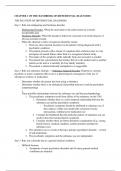Summary
Summary CIDS Final Exam
- Course
- Institution
Summary for the final exam for Clinical Interviewing and Diagnostic Skills (CIDS). Includes Chapter 1 of the handbook of differential diagnoses, all mandatory articles for Personal Recovery, Case Conceptualization, the DSM and HiTOP, and all lectures.
[Show more]



